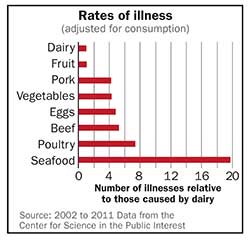Despite our growing ability to find a needle in the "foodborne illness" haystack, as a whole, food safety continues to show steady improvement. Foodborne illnesses reported to the Centers for Disease Control and Prevention fell by a remarkable 42 percent from 2002 to 2011. Delving deeper into the data, the Center for Science in the Public Interest found that dairy caused the lowest level of illnesses, with fruit being a close second, when weighted for consumption. That makes dairy - pound for pound - the safest food at our dinner table.
 From farmer to processor to retailer, our collective efforts to improve upon dairy's already solid safety record has taken a tremendous team effort. Even so, there still is some concern as our wholesome products have caused a few more foodborne-related illnesses in recent years. Unfortunately, this reversal of fortunes has taken place at a time when most food groups are showing a steady improvement. In this development, there appears to be a smoking gun.
From farmer to processor to retailer, our collective efforts to improve upon dairy's already solid safety record has taken a tremendous team effort. Even so, there still is some concern as our wholesome products have caused a few more foodborne-related illnesses in recent years. Unfortunately, this reversal of fortunes has taken place at a time when most food groups are showing a steady improvement. In this development, there appears to be a smoking gun.
Researchers reported that 51 percent of the dairy-related foodborne outbreaks were associated with fluid or beverage milk, pinpointed the Center for Science in the Public Interest. Of that number, 70 percent of outbreaks are due to consuming unpasteurized or "raw" milk. This unfolding situation troubles us as raw, unpasteurized milk was consumed by fewer than one percent of the population. However, it accounted for dairy's biggest black eye. That's a high price to pay for the scant scientific evidence supporting the "benefits" of raw milk.
Even so, dairy has a remarkable story to share. Pound for pound, dairy is the safest food group in the grocery store. Combined with its nutrient-dense food package, dairy is a winning combination that needs to be in every American's diet.
This editorial appears on page 404 of the June 2014 issue of Hoard's Dairyman.
 From farmer to processor to retailer, our collective efforts to improve upon dairy's already solid safety record has taken a tremendous team effort. Even so, there still is some concern as our wholesome products have caused a few more foodborne-related illnesses in recent years. Unfortunately, this reversal of fortunes has taken place at a time when most food groups are showing a steady improvement. In this development, there appears to be a smoking gun.
From farmer to processor to retailer, our collective efforts to improve upon dairy's already solid safety record has taken a tremendous team effort. Even so, there still is some concern as our wholesome products have caused a few more foodborne-related illnesses in recent years. Unfortunately, this reversal of fortunes has taken place at a time when most food groups are showing a steady improvement. In this development, there appears to be a smoking gun.Researchers reported that 51 percent of the dairy-related foodborne outbreaks were associated with fluid or beverage milk, pinpointed the Center for Science in the Public Interest. Of that number, 70 percent of outbreaks are due to consuming unpasteurized or "raw" milk. This unfolding situation troubles us as raw, unpasteurized milk was consumed by fewer than one percent of the population. However, it accounted for dairy's biggest black eye. That's a high price to pay for the scant scientific evidence supporting the "benefits" of raw milk.
Even so, dairy has a remarkable story to share. Pound for pound, dairy is the safest food group in the grocery store. Combined with its nutrient-dense food package, dairy is a winning combination that needs to be in every American's diet.










